|
GfK annually calculates the regional distribution of family types, age ranges, income brackets and accommodation types among Germany's population. The results of the study "GfK Demographics 2012" show that these traits vary starkly from region to region in Germany.
Family types
In 2012, Germany's share of multiple-person households without children exceeded households with children, at 31.2 percent and 28.9 percent re-spectively.

The share of single-person households in Germany is 39.9 percent. As in previous years, Regensburg urban district significantly outpaces Germany's other districts with 55.3 percent, which is 38.5 percent more than the national average. At 54 percent, Berlin urban district ranks second, followed by the urban districts of Würzburg, Munich and Hamburg. Cloppenburg rural district has the lowest share of single-person households at 22.1 percent.
While single-person households tend to be concentrated in large cities or cities with universities, family households with children are often particularly numerous in rural areas. At 41.1 percent, the Bavarian rural district of Landshut has the highest share of children, followed by other Bavarian districts such as Kelheim and Straubing-Bogen. Cloppenburg rural district in the federal state of Lower Saxony ranks fourth at 39.9 percent.
At 38 percent, Cloppenburg also makes the list as the nation's district with the most multiple-person households without children.
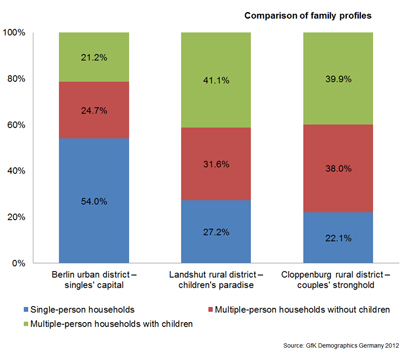
Age distribution
At 35.1 percent, senior households (60 years and older) comprise Germa-ny's ever-growing and most well-represented age range, followed by 40-49 year-olds at 20.8 percent, 50-59 year-olds at 17.8 percent and 30-39 year-olds at 14.7 percent. Young households under 30 are the nation's most underrepresented age range at 11.6 percent.
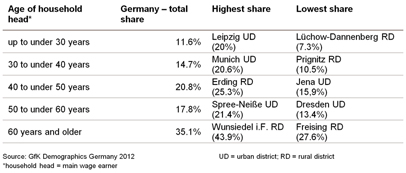
The highest share of young households can be found in the university city of Leipzig: 20 percent of all households here belong to this category, which is almost 72 percent more than the national average.
By contrast, Wunsiedel has the greatest share of senior households at 43.9 percent, which is almost one-fourth more than the national average. Wunsiedel is followed by the district of Baden-Baden, Lüchow-Dannenberg rural district and Chemnitz urban district.
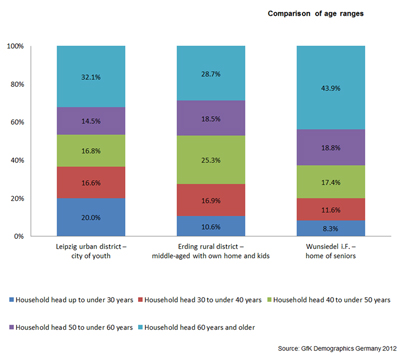
Income brackets
The GfK Demographics study also reveals the socio-economic levels of all households in a given region. These are grouped into seven brackets ac-cording to the amount of disposable monthly income.
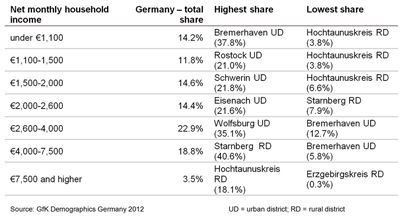
The districts of Hochtaunuskreis, Main-Taunus-Kreis and Starnberg have a share of 16-18 percent of top earners, which is five times the national average of 3.5 percent.
Bremerhaven is Germany's district with the highest share of low earners at 37.8 percent (more than 2.5 times the national average), followed by the urban districts of Trier and Duisburg.
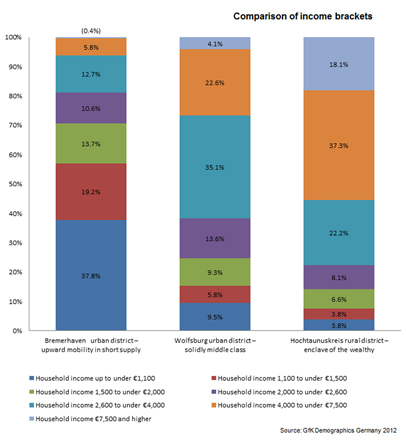
About the study
"GfK Demographics" evaluates socio-demographic data on various regional levels. The dataset provides information on Germany’s population and households according to household type (single- and multiple-person with or without children, immigrant households), age ranges (age of household head), income level (divided into seven income brackets), as well as accommodation type (single- or two-family house, etc.).
Note: New information including income data was incorporated into "GfK Demographics 2012". This results in significant changes to the income bracket distribution among several federal states. We therefore advise against carrying out time series comparisons.
The GfK Demographics dataset is used by marketing and sales divisions for locating target groups. The data reveals the best areas in which to concentrate marketing and sales campaigns.
GfK GeoMarketing offers the GfK Demographics 2012 study for all of Germany's urban and rural districts, municipalities, postcodes, streets and 2.6 million street segments.
Additional information on GfK Demographics can be found at
www.gfk-geomarketing.com/demographics.
| 